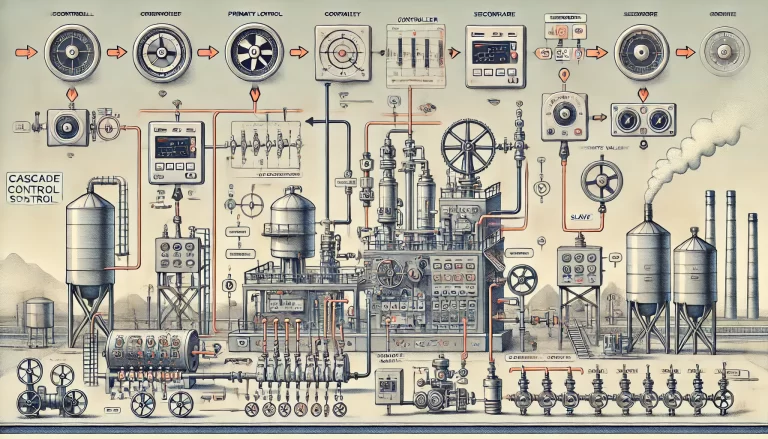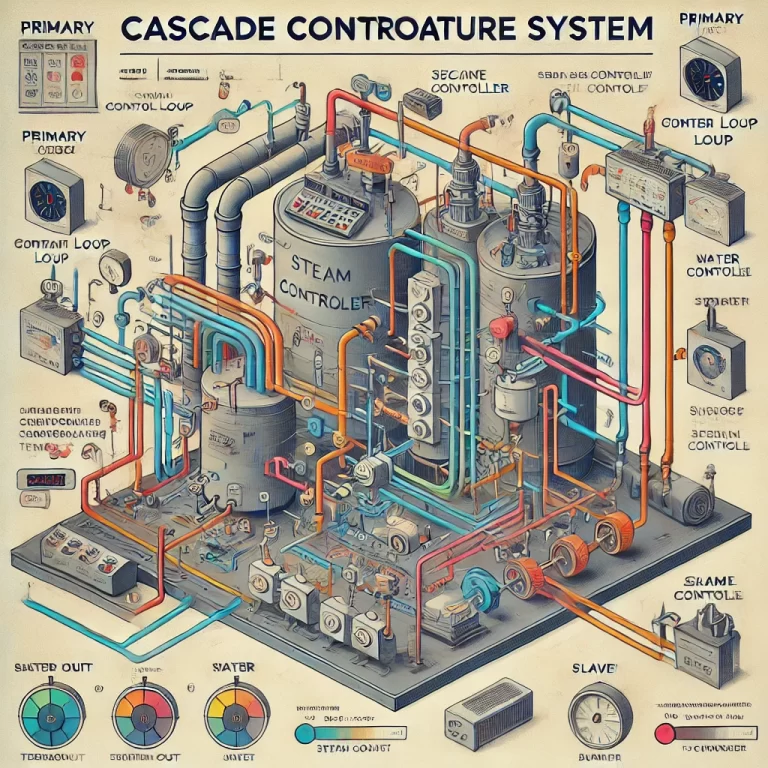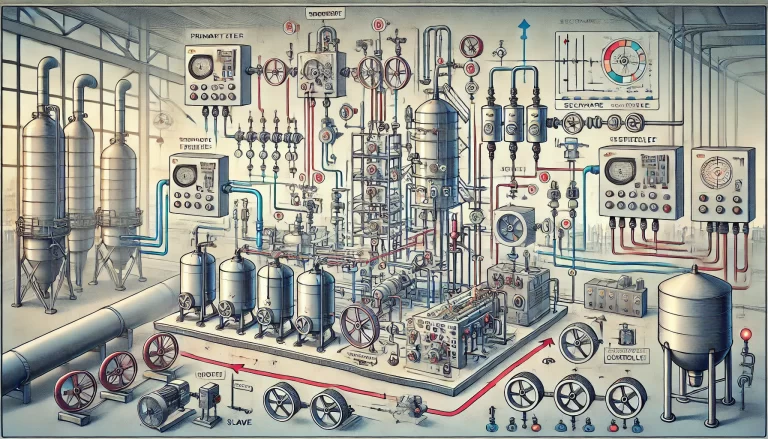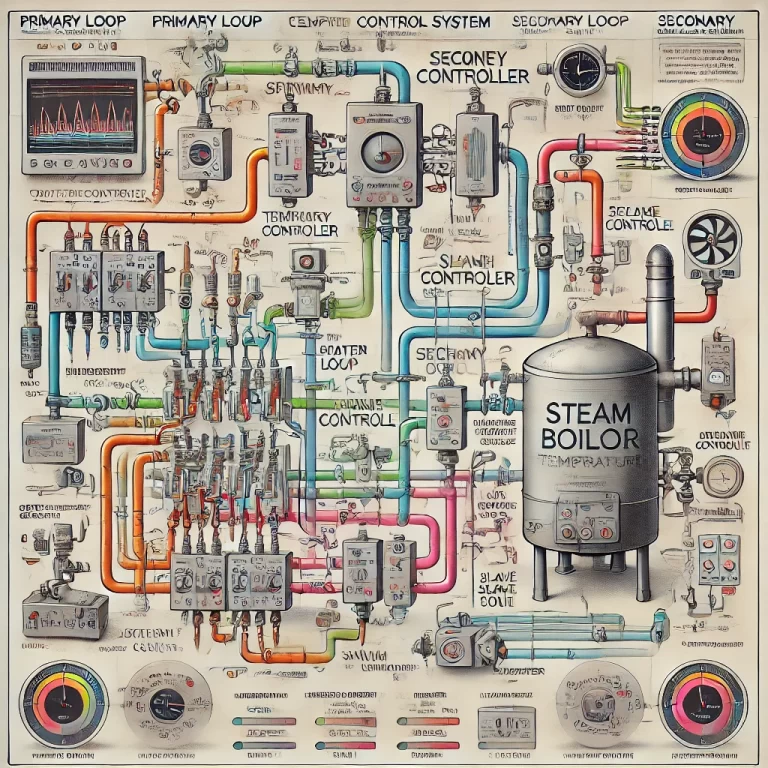1. Introduction
In modern industrial control systems, achieving high precision and stability in complex processes is crucial. Various advanced control strategies and techniques have been developed to meet these demands. Among them, the cascade control system is a classic and effective control method widely used in chemical, power, and metallurgical industries. This article provides a detailed explanation of the principles, characteristics, and real-world applications of cascade control systems.
2. Principles of Cascade Control System
A cascade control system consists of two or more controllers arranged in a series configuration. The primary controller (master controller) determines the desired output and provides the setpoint for the secondary controller (slave controller), which directly controls the actuator. This hierarchical structure enhances the control performance by reducing disturbances and improving response times.
Basic Structure of Cascade Control System
The system comprises two loops:
Primary Loop (Master Control Loop): This loop focuses on the main process variable that must be tightly controlled (e.g., temperature, pressure, flow rate).
Secondary Loop (Slave Control Loop): This loop controls an intermediate variable that directly affects the primary process variable.
Working Mechanism:
When an external disturbance occurs, it first affects the secondary loop.
The secondary controller quickly reacts and adjusts the actuator to compensate for the disturbance.
The primary controller fine-tunes the setpoint of the secondary loop to ensure the overall system maintains stability.
This layered control structure allows faster correction of disturbances before they significantly affect the primary process variable.

3. Characteristics of Cascade Control System
3.1 Enhanced Disturbance Rejection
By introducing a secondary loop, disturbances can be addressed more rapidly before they propagate to the main control loop. This significantly improves the system’s robustness, particularly in processes with long time delays or strong nonlinearities.
3.2 Improved Control Accuracy
Since the secondary controller fine-tunes the intermediate variable, the primary control loop experiences reduced fluctuations, leading to more precise control of the target variable.
3.3 Adaptive Capability
Cascade control systems exhibit better adaptability to changing process conditions. The secondary loop responds to variations in operating conditions, ensuring stable performance without requiring frequent recalibration.
3.4 Reduced Load on the Primary Controller
As the secondary controller handles fast dynamic changes, the primary controller can focus on long-term stability and setpoint tracking, making the overall system easier to tune and maintain.

4. Applications of Cascade Control System
4.1 Application in the Chemical Industry
In chemical production, parameters such as temperature, pressure, and flow rate require strict control. A common example is the distillation column, where maintaining a stable top temperature is crucial for product quality.
Primary Variable: Top temperature of the distillation column
Secondary Variable: Bottom steam flow rate
Implementation: The primary controller regulates the top temperature, while the secondary controller quickly adjusts the steam flow rate to compensate for disturbances (e.g., fluctuations in feed composition).
Benefit: Improved product purity and reduced energy consumption.
4.2 Application in the Power Industry
In power generation, load regulation in steam turbines is critical for grid stability.
Primary Variable: Generator output power
Secondary Variable: Steam valve position
Implementation: When power demand changes, the secondary loop rapidly adjusts the steam valve to stabilize output before the primary controller refines the settings.
Benefit: Faster response to load variations and enhanced grid stability.
4.3 Application in the Metallurgical Industry
During steel production, furnace temperature control is vital for maintaining quality and efficiency.
Primary Variable: Furnace temperature
Secondary Variable: Blower speed (air/fuel ratio)
Implementation: The primary controller maintains the target temperature, while the secondary controller ensures optimal air-fuel mixture for consistent combustion.
Benefit: Stable furnace conditions and improved energy efficiency.

5. Design and Tuning Considerations
5.1 Selection of Primary and Secondary Variables
The primary controlled variable should be the key parameter influencing product quality or system performance.
The secondary controlled variable should have a direct and fast-responding influence on the primary variable.
5.2 Controller Selection and Parameter Tuning
Start by tuning the secondary controller, ensuring it has a fast response to disturbances.
Then, tune the primary controller to optimize the overall process control.
Utilize modern PID tuning methods (e.g., Ziegler-Nichols method, auto-tuning algorithms) to achieve an optimal balance between stability and responsiveness.
5.3 System Architecture and Optimization
Ensure reliable signal transmission to prevent delays or measurement errors.
Minimize sensor noise and interference to enhance control accuracy.
Implement advanced control strategies such as model predictive control (MPC) or adaptive control for further improvements in complex systems.

6. Conclusion
Cascade control systems are widely used in industrial automation due to their superior ability to suppress disturbances, improve precision, and enhance stability. By leveraging a hierarchical control structure, cascade control systems can efficiently regulate complex processes in chemical, power, and metallurgical industries.
With ongoing advancements in process control technologies, integrating cascade control with artificial intelligence (AI), machine learning, and predictive analytics will further optimize system performance. Engineers and process control professionals should explore these developments to enhance industrial efficiency and reliability.
